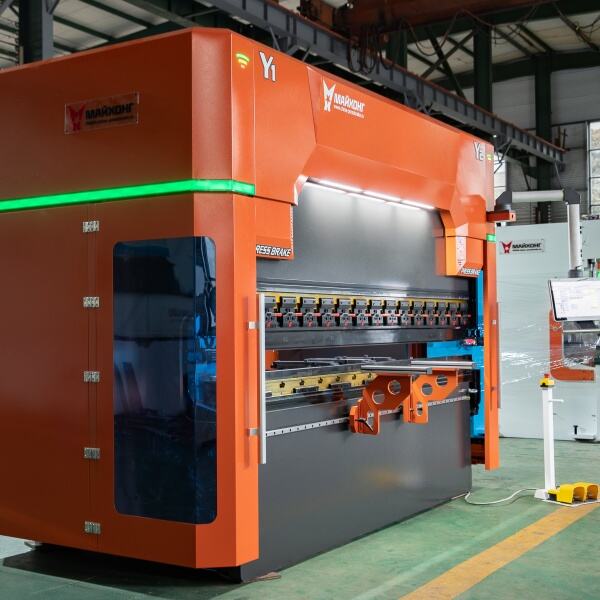Hydraulic Press Brake Mechanics and High-Pressure Performance
Core Components of Hydraulic Press Brake Machines
Hydraulic press brake machines play a vital role across various manufacturing sectors and consist of multiple important parts working together. Looking at what makes them tick, we find the main components: frame structure, moving ram assembly, forming dies, but arguably the heart of the operation lies within the hydraulic system itself. Why? Because this system creates all the force needed for metal bending tasks. Inside, hydraulic cylinders do their thing by turning liquid pressure into actual movement, allowing for accurate bends even under heavy loads. Getting familiar with how each part functions matters quite a bit, particularly when dealing with intense pressure scenarios. Knowing what goes where helps technicians keep these machines running smoothly and makes adjustments easier during routine maintenance. When problems arise with hydraulic CNC press brakes, having this basic understanding becomes invaluable for quick fixes and overall better performance from day one.
Tonnage Capacities for Demanding Applications
When talking about hydraulic press brakes, tonnage capacity stands out as a key spec because it basically tells us how much force the machine can apply when bending different materials. What works for one job might not cut it for another since material demands vary so much across applications. Steel versus aluminum? That makes a big difference in what kind of tonnage we need, especially in those tough industrial settings where things get serious. Take the auto manufacturing sector for instance most plants rely on press brakes that pack around 200 tons of power just to form all the varied parts that go into building cars. Getting this right matters a lot which is why many shops end up chatting with their CNC press brake suppliers before making a purchase. These experts help match machines to actual shop floor needs rather than going by numbers alone.
Precision Engineering in CNC Hydraulic Models
CNC hydraulic press brakes represent a major leap forward in precision work, letting manufacturers bend metal with incredible accuracy thanks to computer controlled systems. Modern units come packed with handy features including auto calibration functions and pre-programmed bending sequences that hit tolerances down to plus or minus 0.01 millimeters. Companies that invest in these machines see real improvements in their workflow speed while cutting down on wasted materials during production runs. The consistent results across all jobs make these presses essential equipment for shops working on parts that require exact measurements time after time. For manufacturers competing in today's tight markets, upgrading to these newer models isn't just smart it's practically necessary if they want to keep up with customer demands for high quality components.
Cross-Industry Applications of Modern Hydraulic Press Brakes
Automotive Frame and Chassis Fabrication
Hydraulic press brakes play a vital role in the automotive sector when it comes to forming car frames and chassis parts that need to hold up under stress and keep drivers safe. The machines can create those intricate shapes needed for today's vehicles, cutting down on production time across assembly lines. Car makers really rely on this feature because they have to juggle strict crash test requirements alongside sleek new design elements. Plus, these presses handle all sorts of metals like high strength steel without breaking a sweat something absolutely critical for building cars that last through harsh winters and summer heat alike.
Aerospace Component Manufacturing
The aerospace industry needs extreme precision when working with materials that are both light and strong, which is why hydraulic press brakes have become so important. These machines handle tough materials like titanium without breaking a sweat something that's critical for making parts used in planes and spacecraft. When it comes to meeting strict safety regulations, hydraulic presses offer advantages because they allow for sophisticated bending methods needed for complicated aircraft structures. Beyond just saving time on production, these machines cut down on wasted material during manufacturing processes, which helps keep costs lower across the board for companies competing in this high-stakes market.
Heavy Machinery Production Techniques
Manufacturing heavy machinery typically depends on strong hydraulic press brakes when making big parts needed across different industries. Most shops end up using specially made dies with these machines since they need extra power to handle whatever comes their way in the field. What makes hydraulic CNC press brakes so valuable is their ability to work with really thick steel plates and other tough materials commonly found in construction equipment. Looking at ways to boost productivity? Many manufacturers are finding that adding automated controls and modernizing older hydraulic systems pays off handsomely. Not only does this cut down on wasted material, but it also means fewer rejects and better overall product quality from batch to batch.
Smart Manufacturing Integration and IoT Innovations
Real-Time Monitoring with IoT-Enabled Systems
Hydraulic press brakes connected to the Internet of Things (IoT) are changing how manufacturing works because they offer real time data tracking. With this information at hand, plant managers can spot problems early on before small issues turn into big headaches, cutting down machine downtime quite a bit. The IoT system does more than just prevent breakdowns too. These smart systems actually boost how well factories run day to day. They predict when things might go wrong using special analytics software, help plan better production timelines, and even manage materials more efficiently. When shops collect all this info while machines are running, they get insights that let them tweak processes without guessing around. Some top names in the CNC press brake business have already jumped on board with these new technologies. For instance, companies like XYZ Manufacturing now offer IoT ready equipment that lets their customers respond faster when orders change unexpectedly or when market conditions shift overnight.
CNC Press Brake Price-to-Performance Considerations
Investing in CNC hydraulic press brakes requires looking at how much bang for the buck we actually get from these machines. The bottom line isn't just about what we pay upfront; maintenance costs, downtime issues, and how efficiently the machine works day to day matter just as much. Finding a model that fits exactly what our shop needs instead of going for something generic saves money in the long run. Good quality hydraulic CNC press brakes typically cut down on scrap material while speeding up production cycles, which means better profits for manufacturers who make smart choices. When comparing prices versus actual performance metrics, shops often find they're getting far more value than expected from models that initially seemed too expensive.
Automation in High-Volume Production
Bringing automation into hydraulic press brake work has become really important for factories that need to produce lots of parts quickly. These automated setups keep running nonstop most of the time, which cuts down on mistakes people might make and boosts how many products get made each day. When workers don't have to touch the machines as much, the results tend to be more accurate and consistent throughout the whole batch. Plus, connecting these presses with other automatic machinery makes everything run smoother from start to finish in the factory. This kind of setup works great for big production runs and fits right into what manufacturers call Industry 4.0 standards nowadays. More shops are switching to automated hydraulic press brakes because they see real benefits in both quality control and keeping up with customer demand for faster turnaround times.
Safety Challenges and Operational Best Practices
Implementing Worker Protection Systems
Safety remains a top concern when operating hydraulic press brakes, so putting proper worker protection systems in place just makes good sense. The basics include things like installing those safety guards around moving parts and setting up automatic shut off mechanisms that kick in if something goes wrong. These simple additions really cut down on accidents and stop equipment from breaking down unexpectedly. Workers should also be given proper gear like gloves, goggles, and hearing protection before they even touch the machine. Training sessions need to happen regularly too. Most shops find that after consistent safety training, accident rates drop noticeably. When everyone knows what they're doing and has the right tools for the job, the whole shop runs smoother and people feel better about coming to work each day.
Maintenance Protocols for Hydraulic Reliability
Regular maintenance routines are key if hydraulic press brakes need to keep running reliably over time. Maintenance should cover things like checking for signs of wear during routine inspections, changing out old hydraulic fluid at set intervals to keep everything operating smoothly, and making sure those cylinders stay properly aligned. When these basic steps get done on schedule, machines are much less likely to break down unexpectedly and will perform consistently cycle after cycle. Facilities that stick with good maintenance practices find they spend less money fixing sudden breakdowns and their equipment lasts longer overall. For most shops, this kind of preventive care pays off handsomely in both reduced costs and increased productivity.
Evaluating CNC Press Brake Suppliers
Finding a good CNC press brake supplier makes all the difference when it comes to running operations smoothly over time. When looking around, there are a few things worth paying attention to. First off, check what kind of machines they actually offer - does the quality match what we need? Then look at those warranty terms because nobody wants surprises down the road. Technical support availability matters too; nobody has time waiting for fixes when production stops. Don't forget to dig into what other customers say about them either. Reading through actual feedback from similar businesses gives real insight into how well they handle day-to-day issues. This kind of groundwork helps ensure whatever press brake gets selected won't just sit nicely on paper but actually works within existing workflows without causing headaches later on.
FAQ
What are the core components of a hydraulic press brake?
The core components of a hydraulic press brake include the frame, ram, dies, and the hydraulic system. The hydraulic system is crucial as it generates the pressure needed for bending operations.
Why is tonnage capacity important in hydraulic press brakes?
Tonnage capacity is important because it determines the maximum force the machine can exert to bend materials. This is vital for handling various materials in different industrial applications.
How does IoT enhance hydraulic press brake performance?
IoT enhances performance by providing real-time data monitoring for proactive maintenance, reducing downtime, and optimizing production efficiency through predictive analytics.
What safety measures are important for press brake operation?
Essential safety measures include installing safety guards, automatic shut-off systems, providing personal protective equipment, and ensuring regular training on safe operation techniques.
How can I choose the right CNC press brake supplier?
Evaluate the supplier based on equipment quality, warranty provisions, technical support, and industry reputation. This ensures seamless integration into production processes.



